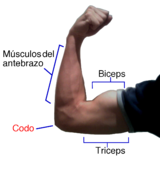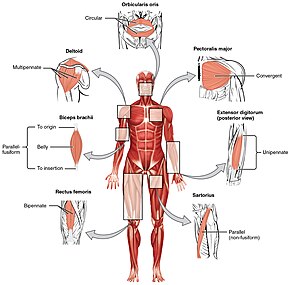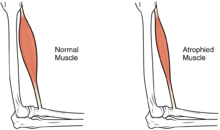with respect to muscles, what do the terms origin, insertion, and belly mean
Anatomical terminology is used to uniquely describe aspects of skeletal muscle, cardiac musculus, and smooth muscle such as their actions, construction, size, and location.
Types [edit]
There are three types of musculus tissue in the body: skeletal, smooth, and cardiac.
Skeletal muscle [edit]
Skeletal musculus, or "voluntary muscle", is a striated musculus tissue that primarily joins to bone with tendons. Skeletal musculus enables movement of bones, and maintains posture.[i] The widest part of a muscle that pulls on the tendons is known as the belly.
Muscle slip [edit]
A muscle sideslip is a sideslip of muscle that can either exist an anatomical variant,[2] or a branching of a muscle as in rib connections of the serratus inductive musculus.
Smooth muscle [edit]
Smooth musculus is involuntary and found in parts of the body where information technology conveys activity without witting intent. The majority of this type of muscle tissue is establish in the digestive and urinary systems where it acts by propelling forward food, chyme, and feces in the former and urine in the latter. Other places smooth muscle can exist plant are within the uterus, where it helps facilitate birth, and the centre, where the pupillary sphincter controls pupil size.[3]
Cardiac muscle [edit]
Cardiac musculus is specific to the heart. It is also involuntary in its motion, and is additionally self-excitatory, contracting without outside stimuli.[4]
Deportment of skeletal muscle [edit]
Also as anatomical terms of motion, which draw the movement made by a muscle, unique terminology is used to describe the action of a set of muscles.
Agonists and antagonists [edit]
Agonist muscles and antagonist muscles are muscles that cause or inhibit a movement.[5]
Agonist muscles are also called prime number movers since they produce well-nigh of the forcefulness, and control of an activity.[6] Agonists cause a movement to occur through their own activation.[7] For example, the triceps brachii contracts, producing a shortening (concentric) contraction, during the upwards phase of a button-up (elbow extension). During the downwardly stage of a push-upward, the same triceps brachii actively controls elbow flexion while producing a lengthening (eccentric) contraction. It is still the agonist, because while resisting gravity during relaxing, the triceps brachii continues to be the prime number mover, or controller, of the joint action.
Another example is the dumb-bell whorl at the elbow. The elbow flexor group is the agonist, shortening during the lifting phase (elbow flexion). During the lowering stage the elbow flexor muscles lengthen, remaining the agonists because they are controlling the load and the motility (elbow extension). For both the lifting and lowering stage, the "elbow extensor" muscles are the antagonists (see beneath). They lengthen during the dumbbell lifting phase and shorten during the dumbbell lowering stage. Here it is of import to understand that it is mutual exercise to give a name to a musculus group (e.g. elbow flexors) based on the joint activity they produce during a shortening contraction. Withal, this naming convention does not mean they are only agonists during shortening. This term typically describes the office of skeletal muscles.[8]
Antagonist muscles are only the muscles that produce an opposing joint torque to the agonist muscles.[9] This torque can assistance in controlling a motion. The opposing torque can dull movement down - peculiarly in the example of a ballistic move. For example, during a very rapid (ballistic) discrete movement of the elbow, such as throwing a sprint, the triceps muscles volition be activated very briefly and strongly (in a "flare-up") to speedily accelerate the extension movement at the elbow, followed nearly immediately by a "burst" of activation to the elbow flexor muscles that decelerates the elbow movement to arrive at a quick terminate. To use an automotive analogy, this would exist similar to pressing the accelerator pedal rapidly and so immediately pressing the brake. Antagonism is not an intrinsic property of a detail muscle or muscle group; it is a part that a muscle plays depending on which muscle is currently the agonist. During slower articulation actions that involve gravity, just equally with the agonist muscle, the antagonist muscle can shorten and lengthen. Using the example of the triceps brachii during a push button-up, the elbow flexor muscles are the antagonists at the elbow during both the upwardly phase and down phase of the movement. During the dumbbell curl, the elbow extensors are the antagonists for both the lifting and lowering phases.[10]
Antagonistic pairs [edit]

The antagonistic pair of biceps and triceps working to flex the elbow.
Antagonist and agonist muscles ofttimes occur in pairs, called antagonistic pairs. Equally one musculus contracts, the other relaxes. An example of an antagonistic pair is the biceps and triceps; to contract, the triceps relaxes while the biceps contracts to lift the arm. "Contrary motions" need antagonistic pairs located in opposite sides of a joint or bone, including abductor-adductor pairs and flexor-extensor pairs. These consist of an extensor musculus, which "opens" the articulation (by increasing the angle between the two bones) and a flexor muscle, which does the opposite by decreasing the angle between 2 bones.
However, muscles don't ever work this way; sometimes agonists and antagonists contract at the same fourth dimension to produce force, as per Lombard'due south paradox. As well, sometimes during a articulation action controlled by an agonist musculus, the adversary will be slightly activated, naturally. This occurs normally and is not considered to exist a trouble unless it is excessive or uncontrolled and disturbs the control of the joint action. This is chosen agonist/antagonist co-activation and serves to mechanically stiffen the joint.
Not all muscles are paired in this way. An example of an exception is the deltoid.[11]
Synergists [edit]

The biceps flexes the lower arm. The brachioradialis, in the forearm, and brachialis, located deep to the biceps in the upper arm, are both synergists that aid in this motility.
Synergist muscles also chosen fixators, deed around a joint to help the action of an agonist muscle. Synergist muscles can as well act to counter or neutralize the force of an agonist and are besides known equally neutralizers when they do this.[12] Every bit neutralizers they help to cancel out or neutralize extra movement produced from the agonists to ensure that the force generated works within the desired plane of motion.
Muscle fibers can only contract up to 40% of their fully stretched length. Thus the short fibers of pennate muscles are more than suitable where power rather than range of contraction is required. This limitation in the range of contraction affects all muscles, and those that act over several joints may exist unable to shorten sufficiently to produce the full range of movement at all of them simultaneously (agile insufficiency, e.g., the fingers cannot be fully flexed when the wrist is also flexed). Likewise, the opposing muscles may be unable to stretch sufficiently to allow such motion to take place (passive insufficiency). For both these reasons, it is frequently essential to use other synergists, in this type of activity to ready sure of the joints so that others can exist moved finer, e.g., fixation of the wrist during full flexion of the fingers in clenching the fist. Synergists are muscles that facilitate the fixation action.
There is an of import divergence between a helping synergist muscle and a true synergist muscle. A true synergist muscle is one that only neutralizes an undesired joint action, whereas a helping synergist is i that neutralizes an undesired action simply besides assists with the desired activeness.[ commendation needed ]
Neutralizer action [edit]
A musculus that fixes or holds a bone so that the agonist can carry out the intended movement is said to take a neutralizing action. A good famous example of this are the hamstrings; the semitendinosus and semimembranosus muscles perform human knee flexion and human knee internal rotation whereas the biceps femoris carries out articulatio genus flexion and articulatio genus external rotation. For the knee to flex while not rotating in either direction, all three muscles contract to stabilize the knee while it moves in the desired mode.
Composite muscle [edit]
Composite or hybrid muscles have more than one set of fibers that perform the same function, and are usually supplied by unlike nerves for different set of fibers. For case, the tongue itself is a composite muscle made up of various components like longitudinal, transverse, horizontal muscles with dissimilar parts innervated having different nerve supply.
Muscle naming [edit]

The seven general types of skeletal musculus
At that place are a number of terms used in the naming of muscles including those relating to size, shape, action, location, their orientation, and their number of heads.
- By size
- brevis means brusque; longus means long; major ways large; maximus ways largest; pocket-sized ways small, and minimus smallest. These terms are often used after the particular muscle such equally gluteus maximus, and gluteus minimus.[13]
- Past shape
- deltoid means triangular; quadratus means having iv sides; rhomboideus means having a rhomboid shape; teres means round or cylindrical, trapezius means having a trapezoid shape, rectus means straight. Examples are the pronator teres, the pronator quadratus and the rectus abdominis.[13]
- Past activeness
- abductor moving away from the midline; adductor moving towards the midline; depressor moving downwards; lift moving upwards; flexor moving that decreases an bending; extensor moving that increase an angle or straightens; pronator moving to face down; supinator moving to face up upwards;[13] Internal rotator rotating towards the body; external rotator rotating away from the trunk.
Class [edit]

Insertion and origin [edit]
The insertion and origin of a muscle are the two places where information technology is anchored, 1 at each cease. The connective tissue of the attachment is chosen an enthesis.
Origin [edit]
The origin of a muscle is the os, typically proximal, which has greater mass and is more than stable during a contraction than a muscle'south insertion. [14] For example, with the latissimus dorsi muscle, the origin site is the torso, and the insertion is the arm. When this muscle contracts, normally the arm moves due to having less mass than the trunk. This is the case when grabbing objects lighter than the body, equally in the typical utilise of a lat pull down machine. This tin be reversed however, such as in a chin up where the trunk moves up to meet the arm.
The caput of a muscle, also chosen caput musculi is the part at the end of a muscle at its origin, where information technology attaches to a fixed os. Some muscles such as the biceps have more than 1 head.
Insertion [edit]
The insertion of a musculus is the structure that it attaches to and tends to exist moved by the wrinkle of the muscle. [fifteen] This may be a os, a tendon or the subcutaneous dermal connective tissue. Insertions are normally connections of muscle via tendon to os.[16] The insertion is a bone that tends to be distal, have less mass, and greater motion than the origin during a contraction.
Intrinsic and extrinsic muscles [edit]
Intrinsic muscles have their origin in the part of the body that they deed on, and are independent within that part.[17] Extrinsic muscles have their origin outside of the part of the trunk that they act on.[xviii] Examples are the intrinsic and extrinsic muscles of the tongue, and those of the mitt.
Muscle fibers [edit]

Muscles may also be described by the direction that the muscle fibers run, in their muscle architecture.
- Fusiform muscles have fibers that run parallel to the length of the musculus, and are spindle-shaped.[19] For case, the pronator teres muscle of the forearm.
- Unipennate muscles have fibers that run the entire length of only one side of a musculus, similar a quill pen. For case, the fibularis muscles.
- Bipennate muscles consist of two rows of oblique musculus fibres, facing in opposite diagonal directions, converging on a central tendon. Bipennate muscle is stronger than both unipennate musculus and fusiform muscle, due to a larger physiological cross-sectional area. Bipennate muscle shortens less than unipennate muscle simply develops greater tension when it does, translated into greater power just less range of motion. Pennate muscles by and large also tire hands. Examples of bipennate muscles are the rectus femoris muscle of the thigh, and the stapedius musculus of the middle ear.
Land [edit]
Hypertrophy and atrophy [edit]

Instance of an atrophied muscle
Hypertrophy is increase in muscle size from an increment in size of individual musculus cells. This usually occurs as a outcome of do.
Meet also [edit]
- Reciprocal inhibition
- Anatomical terms of bone
- Anatomical terms of neuroanatomy
References [edit]
![]() This article incorporates text in the public domain from the 20th edition of Greyness'south Anatomy (1918)
This article incorporates text in the public domain from the 20th edition of Greyness'south Anatomy (1918)
- ^ Skeletal Musculus
- ^ Stimec, Bojan V.; Dash, Jérémy; Assal, Mathieu; Stern, Richard; Fasel, Jean H. D. (1 May 2018). "Boosted muscular slip of the flexor digitorum longus muscle to the fifth toe". Surgical and Radiologic Anatomy. pp. 533–535. doi:x.1007/s00276-018-1991-7. Retrieved thirteen May 2021.
- ^ Smooth Musculus
- ^ Cardiac Muscle
- ^ "Interactions of skeletal muscles their fascicle arrangement and their lever-systems". Retrieved x May 2021.
- ^ Saladin, Kenneth S. (2011). Human anatomy (3rd ed.). New York: McGraw-Loma. pp. 236–241. ISBN9780071222075.
- ^ Taber 2001, pp. "Agonist".
- ^ Baechle, Thomas (2008). Essentials of Strength Training and Conditioning. U.s.a.: National Strength and Conditioning Association. ISBN978-0-7360-8465-9.
- ^ Taber 2001, pp. "Antagonist".
- ^ Walker, Kenneth. "Clinical Methods: The History, Physical, and Laboratory Examinations. 3rd edition". ncbi. BUTTERWORTH.
- ^ Purves, D; Augustine, GJ. "Neural Circuits". NCBI. Sinauer Association.
- ^ "nine.6C: How Skeletal Muscles Produce Movements". Medicine LibreTexts. 19 July 2018. Retrieved eight May 2021.
- ^ a b c Saladin, Kenneth Due south. (2011). Homo anatomy (3rd ed.). New York: McGraw-Hill. p. 265. ISBN9780071222075.
- ^ OED 1989, "origin".
- ^ Taber 2001, "insertion".
- ^ Martini, Frederic; William C. Ober; Claire W. Garrison; Kathleen Welch; Ralph T. Hutchings (2001). Fundamentals of Anatomy and Physiology, 5th Ed. Prentice Hall. ISBN0130172928.
- ^ "Definition of INTRINSIC". www.merriam-webster.com . Retrieved 7 May 2021.
- ^ "Definition of EXTRINSIC". www.merriam-webster.com . Retrieved vii May 2021.
- ^ Taber 2001, "Fusiform".
- Books
- Willert, editor Donald Venes, Coeditor Clayton L. Thomas, Managing Editor Elizabeth J. Egan, Assistant Editors Nancee A. Morelli and Alison D. Nell. /copy Editor Ann Houska Proofreaders Joy Matkowski and Christopher Muldor. Dictionary Illustrator Beth Anne (2001). Taber's cyclopedic medical dictionary (Ed. 19, illustrated in full colour ed.). Philadelphia: F.A.Davis Co. ISBN0-8036-0655-9.
- J. A. Simpson, ed. (1989). The Oxford English dictionary . Oxford: Clarendon Press. ISBN9780198611868.
chumleythicithe2002.blogspot.com
Source: https://en.wikipedia.org/wiki/Anatomical_terms_of_muscle
0 Response to "with respect to muscles, what do the terms origin, insertion, and belly mean"
Post a Comment